|
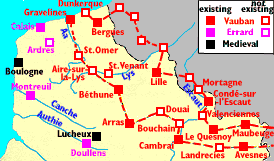 Â Â Â Â 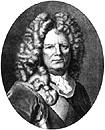
1.
Map of Forts in present-day
Nord/ Pas-de-Calais, showing the outer defences given up in
1713 when the Treaty
of Utrecht re-drwe the
border.
2.
Portrait:
SĂ©bastien le Prestre de Vauban (1633-1707)
|
|
Fortifying northern France
As the area of French rule expanded towards its present
borders, defences were built to secure the gains. At the
beginning of the 17th century, Henri IV employed Jean
Errard (1554-1610), the "father of French
fortification", to build a number of citadels in the north -
following Italian ideas.
Vauban
When King Louis
XIV's army had successfully
advanced into the lowlands of Spanish
Flanders in the second half of
the 17th century, he commissioned his military engineer
SĂ©bastien le Prestre de Vauban (1633-1707) to
design and supervise the building of a chain of forts. These
were designed to ensure that France's north-east border
lands could never be recaptured.
|
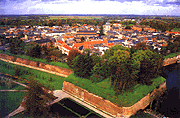
Le Quesnoy - fortified by Vauban to help strengthen a weak
area on France's new borders.
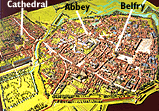
Model of Arras made in 1716, showing the walled town
captured by Louis XIV from the Spanish in 1667 - with modern
fortifications added by Vauban: a citadelle, earthworks,
bastions and ditches to strengthen the medieval town walls.
(in the Musée des Beaux-Arts, Arras)
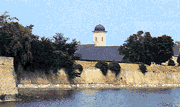
Gravelines on the banks of the river Aa held the coastal end
of the inner chain of forts...
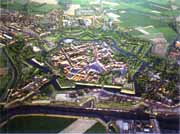
...from the air, you can see the classic star shape of
Vauban's designs.
|
|
Weapons

By the 17th century, weapons and tactics had
developed to make old medieval fortifications generally
useless against attack by an organised army. Thick stone
walls and towers simply crumbled into ruins when attacked by
modern cannons; defenders needed a strong base from which
they could safely use the increasingly accurate firepower of
guns.
Vauban joined Louis XIV's army in 1658.
Over the next few decades, he directed 53 sieges, with a
keen eye for any weak spot in a town's defences.
Design
Vauban's genius was as a "poacher turned gamekeeper".
Knowing how he would attack a stronghold, his solution was
to build "star-shaped" forts with straight-sided moats,
lined with walls built of local materials (mainly brick in
the north). He left no “blind spots” where an
attacker could hide. His defenders could fire on the enemy
with cannon mounted behind thick walls on the ramparts; and
rake the moats with handguns fired through slits in the
walls.
He carefully took advantage of natural
features, such as rivers and hill-slopes, in siting his
forts - using detailed models to help the design, and often
adapting earlier fortifications.
Lines of forts
With royal command to give him all the men and materials
needed, Vauban built a long double line of forts called the
"Pré carré" - each sited and designed so that
a small garrison could hold up any invading army, giving
time for reinforcements to be organised. Some of the forward
line was lost (see
map) in 1713, when the
Treaty of
Utrecht re-drew the frontier,
forcing Louis XIV to give back some of his
conquests.
|
|
Meteoric rise, prodigious
workload
|
|
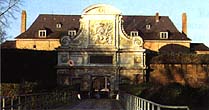
At Lille, Vauban was made Governor and built a new Citadelle
1667-70 to make the regional capital an impregnable
stronghold. The gateway bears the sun-symbol of Louis XIV,
and a fresco representing the arts that flourished under his
reign.
|
Louis XIV met Vauban during his
campaigns, was impressed with his ability, and promoted him
swiftly. In 1668 he was made Governor of newly-captured
Lille.
During his military career, Vauban built
33 forts and fortified walled towns, and strengthened 300
others - not just in Nord- Pas de Calais, but all round the
coasts and borders of France.
He reached the dizzy heights of
"Maréchal of France" in 1703, but fell from favour
with Louis
XIV in 1706 - a year before he
died.
|
|
Ideas for tax reform
His "crime"? - Vauban published books with ideas for social
reforms. The king objected to a book that dared to suggest
solving the kingdom's chronic budget deficit by levying a
new proportionate income tax even on the aristocracy (who
unfairly paid little or no tax). Vauban was banished from
the Versailles court, and died in disgrace a year later. A
century later, Napoleon
recognised Vauban's military genius and had him reburied
with honour in the Panthéon.
|
|
Successful
Despite the gaps left by the 1713 frontier change
(see
map), Vauban's lines of fortified
towns helped France to successfully defend its northern
border until the invasions at the end of the
Napoleonic
Wars (1814-5). In the
Franco-Prussian
War (1870-1) the Prussians
avoided the north by attacking further east. By the
First World
War, military technology had made
the forts obsolete. Germany invaded the north through
Belgium in 1914, proving this low-lying frontier was again
vulnerable - and prompting the French to build the infamous
"Maginot Line" in later years.
Museum
Today most of the models that were made to help Vauban in
planning his effective and innovative fortifications can be
seen in a museum in Lille, the Musée
des Beaux-Arts.
|








